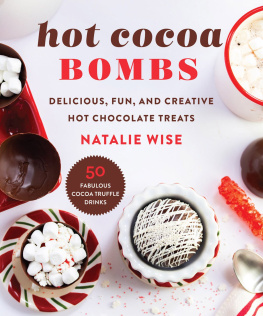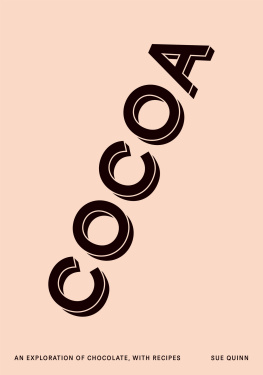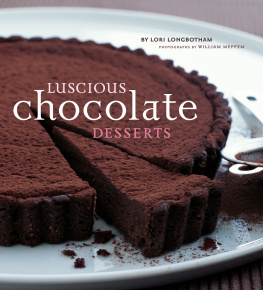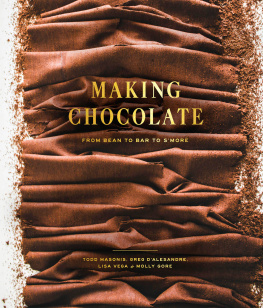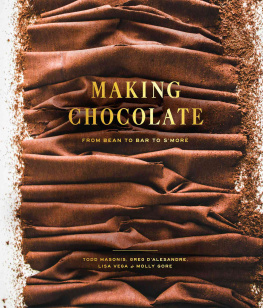Chocolate and Cocoa Recipes
By Miss Parloa
and
Home Made Candy Recipes
By Mrs. Janet McKenzie Hill

Compliments of Walter Baker & Co., Ltd.
ESTABLISHED DORCHESTER, MASS. 1780.
~~**~~
Published by My Ebook Publishing House
Book: Chocolate and Cocoa Recipes and Home Made Candy Recipes, by Miss Parloa, Public Domain
~~**~~
~~**~~
Other Titles from My Ebook Publishing House:
~~**~~
INDEX TO RECIPES
MISS PARLOA'S:
Plain Chocolate (For Drinking)
Chocolate, Vienna Style
Breakfast Cocoa
Chocolate Layer Cake
Chocolate Cake
Chocolate Marble Cake
Chocolate Glac Cake
Chocolate Glac
Chocolate Biscuit
Chocolate Wafers
Cinderella Cakes
Chocolate clairs
Chocolate Cookies
Chocolate Gingerbread
Vanilla Icing
Chocolate Icing
Chocolate Profiteroles
Chocolate Ice-cream
Chocolate Cream Pies
Chocolate Mousse
Chocolate Charlotte
Chocolate Bavarian Cream
Chocolate Cream
Chocolate Blanc-mange
Chocolate Cream Renversee
Baked Chocolate Custard
Chocolate Souffl
Chocolate Pudding
Chocolate Meringue Pudding
Milton Pudding
Snow Pudding
Chocolate Sauce
Chocolate Candy
Cream Chocolate Caramels
Sugar Chocolate Caramels
Chocolate Creams, No. 1
Chocolate Creams No. 2
Chocolate Cones
Genesee Bonbons
Chocolate Syrup
Refreshing Drinks for Summer
MISS BURR'S:
Cracked Cocoa
For Three Gallons Breakfast Cocoa
Vanilla Chocolate with Whipped Cream
Chocolate Cream Pie
Chocolate Filling
Meringue
Cocoa Sticks
Cocoa Frosting
Cocoa Sauce
Cocoa Cake
Cocoa Meringue Pudding
Chocolate Almonds
Hot Chocolate Sauce
Cocoa Sponge Cake
Chocolate Frosting
Chocolate Cake; or, Devil's Food
Chocolate Ice-cream
Chocolate Whip
Cocoa Marble Cake
Chocolate Marble Cake
Chocolate Jelly
Cottage Pudding
Vanilla Sauce
Cocoanut Souffl
Chocolate Sauce
Cocoa Biscuit
Cocoa Fudge
MISS ROBINSON'S:
Plain Chocolate 1 quart
Cocoa Sponge Cake
Cocoa Marble Cake
Cocoa Doughnuts
Cocoa Buns
MRS. RORER'S:
Chocolate Cake
MRS. LINCOLN'S:
Chocolate Caramels
MISS FARMER'S:
Chocolate Nougat Cake
Chocolate Cream Candy
MRS. ARMSTRONG'S:
Chocolate Pudding
Chocolate Charlotte
Chocolate Jelly with Crystallized Green Gages
MRS. BEDFORD'S:
Chocolate Crullers
Hot Cocoa Sauce for Ice-cream
Chocolate Macaroons
MRS. EWING'S:
Creamy Cocoa
Creamy Chocolate
MRS. HILL'S:
Cocoa Frapp
Chocolate Puffs
MRS. SALZBACHER'S:
Chocolate Hearts
Cocoa Charlotte
Chocolate Fudge with Fruit
Chocolate Macaroons
Petits Four
Potato Cake
Spanish Chocolate Cake
MRS. HILL'S CANDY RECIPES:
Peppermints, Chocolate Mints, etc.
Chocolate Caramel Walnuts
"Dot" Chocolate Coatings
Chocolate Dipped Peppermints
Ginger, Cherry, Apricot and Nut Chocolates
Chocolate Peanut Clusters
Chocolate Coated Almonds
Chocolate Dipped Parisian Sweets
Stuffed Dates, Chocolate Dipped
Chocolate Oysterettes
Turkish Paste with French Fruit
Chocolate Pecan Pralines
Vassar Fudge
Smith College Fudge
Wellesley Marshmallow Fudge
Double Fudge
Marbled Fudge
Fudge Hearts or Rounds
Marshmallow Fudge
Chocolate Dipped Fruit Fudge
Chocolate Cocoanut Cakes
Baker's Chocolate "Divinity"
Chocolate Nougatines
Plain Chocolate Caramels
Chocolate Nut Caramels
Ribbon Caramels
Fondant
Almond Chocolate Creams
Cherry Chocolate Creams
Chocolate Peppermints
Fig and Nut Chocolates
Chocolate Marshmallows
Maple Fondant Acorns
Chocolate Almond Bars
Almond Fondant Sticks
Almond Fondant Balls
Walnut Cream Chocolates
To Mold Candy for Dipping
Chocolate Butter Creams
Fondant for Soft Chocolate Creams
Rose Chocolate Creams
Pistachio Chocolate Creams
Surprise Chocolate Creams
Chocolate Peanut Brittle
Chocolate Pop Corn Balls
Chocolate Molasses Kisses
Cocoa and Chocolate
The term "Cocoa," a corruption of "Cacao," is almost universally used in English-speaking countries to designate the seeds of the small tropical tree known to botanists as THEOBROMA CACAO, from which a great variety of preparations under the name of cocoa and chocolate for eating and drinking are made. The name "Chocolatl" is nearly the same in most European languages, and is taken from the Mexican name of the drink, "Chocolate" or "Cacahuatl." The Spaniards found chocolate in common use among the Mexicans at the time of the invasion under Cortez in 1519, and it was introduced into Spain immediately after. The Mexicans not only used chocolate as a staple article of food, but they used the seeds of the cacao tree as a medium of exchange.
No better evidence could be offered of the great advance which has been made in recent years in the knowledge of dietetics than the remarkable increase in the consumption of cocoa and chocolate in this country. The amount retained for home consumption in 1860 was only 1,181,054 pounds about 3-5 of an ounce for each inhabitant. The amount retained for home consumption for the year ending Dec. 31, 1908, was 93,956,721 pounds over 16 ounces for each inhabitant.
Although there was a marked increase in the consumption of tea and coffee during the same period, the ratio of increase fell far below that of cocoa. It is evident that the coming American is going to be less of a tea and coffee drinker, and more of a cocoa and chocolate drinker. This is the natural result of a better knowledge of the laws of health, and of the food value of a beverage which nourishes the body while it also stimulates the brain.
Baron von Liebig, one of the best-known writers on dietetics, says:
"It is a perfect food, as wholesome as delicious, a beneficient restorer of exhausted power; but its quality must be good and it must be carefully prepared. It is highly nourishing and easily digested, and is fitted to repair wasted strength, preserve health, and prolong life. It agrees with dry temperaments and convalescents; with mothers who nurse their children; with those whose occupations oblige them to undergo severe mental strains; with public speakers, and with all those who give to work a portion of the time needed for sleep. It soothes both stomach and brain, and for this reason, as well as for others, it is the best friend of those engaged in literary pursuits."
M. Brillat-Savarin, in his entertaining and valuable work, Physiologie du Got , says: "Chocolate came over the mountains [from Spain to France] with Anne of Austria, daughter of Philip III and queen of Louis XIII. The Spanish monks also spread the knowledge of it by the presents they made to their brothers in France. It is well known that Linnus called the fruit of the cocoa tree theobroma , 'food for the gods.' The cause of this emphatic qualification has been sought, and attributed by some to the fact that he was extravagantly fond of chocolate; by others to his desire to please his confessor; and by others to his gallantry, a queen having first introduced it into France.
"The Spanish ladies of the New World, it is said, carried their love for chocolate to such a degree that, not content with partaking of it several times a day, they had it sometimes carried after them to church. This favoring of the senses often drew upon them the censures of the bishop; but the Reverend Father Escobar, whose metaphysics were as subtle as his morality was accommodating, declared, formally, that a fast was not broken by chocolate prepared with water; thus wire-drawing, in favor of his penitents, the ancient adage, ' Liquidum non frangit jejunium. '
Next page



